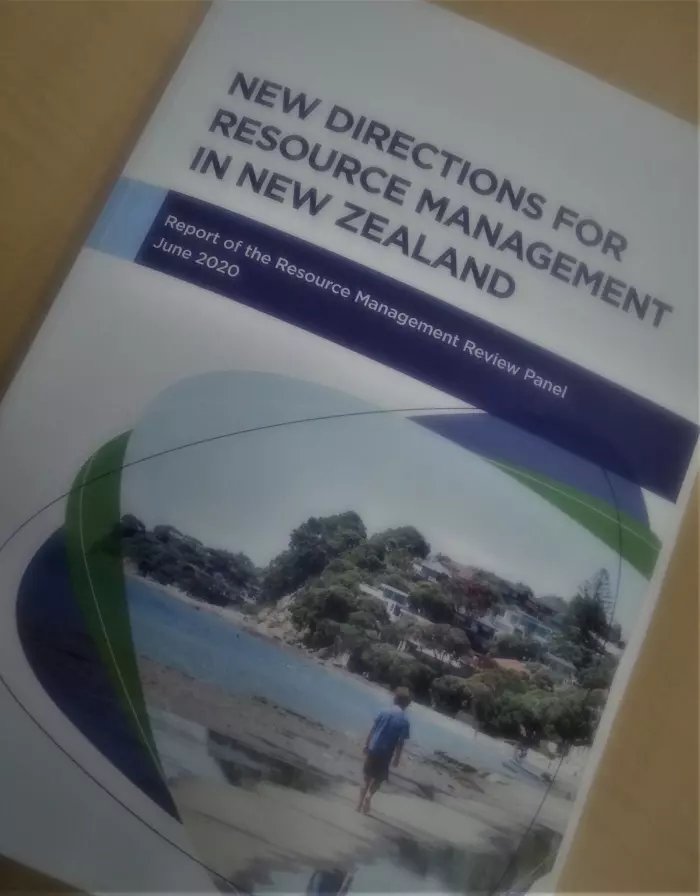Passed in 1991, the Resource Management Act was revolutionary at the time and the creature of a pioneering legislator, Geoffrey Palmer.
It placed ‘sustainable development’ at the heart of new law that was intended to govern land use, resource development and environmental protection, focusing on a range of environmental ‘bottom lines’ and a desire to control the adverse environmental effects of human activity.
After 29 years, however, the RMA has become a byword for a handbrake on economic growth, a primary reason for the high cost of residential land and construction, and a bureaucratic nightmare.
Environment Minister David Parker shorthands its shortcomings by saying it is “too slow, too expensive and hasn’t protected the environment.”
Every political party agrees it should change, and today’s whopper 531-page report from a working group led by retired Environment Court judge Tony Randerson, lays out a new approach that Parker will be hoping can produce a less sullied legacy than the RMA has for Palmer.
While it is not all Labour Party policy yet, Parker indicated today that a Labour-led government after the Sept. 19 election would seek to put the new regime in place within three years – a possibly heroic objective given the scale of the shake-up envisaged.
The main benefits? Faster and fewer resource consents at lower cost; far better national planning for where towns, cities, roads, industries, agriculture and nature will co-exist; stronger Maori involvement in strategic decisions; better economic and environmental outcomes; less bias towards the status quo over what may be better in the future.
So, what are its main features and differences from the current RMA:
- The RMA becomes two pieces legislation: a Natural and Built Environments Act and a Strategic Planning Act. This split is sometimes being reported as separate ‘planning’ and ‘environmental protection’ acts. That is not accurate. The NBEA and SPA are integrated pieces of legislation. The NBEA will contain revised purposes and principles that replace those in the RMA and will focus on “achieving positive outcomes” rather than “managing environmental effects." The SPA will require regional spatial planning covering all of NZ’s landmass and coastal marine areas. The new legislative package will also have impacts on local government, land transport management, and climate change response law
- Far fewer local government planning documents: Instead of more than 100 overlapping and often contradictory regional and local government planning documents to guide economic development and environmental protection, there will be just 14. This will require regional councils and local territorial authorities to work together far more closely. The earlier involvement of the Environment Court in plan-making should also reduce the number of layers at which objectors can appeal against resource consents
- This is not local government amalgamation: Parker insists this is not local government amalgamation by stealth and that variations within plan areas will be possible, depending on locally expressed democratic opinions. The Randerson panel chanced its arm by saying NZ is over-governed with 78 regional and local authorities. Parker said the problem in NZ is “too many plans, not too many councils” and that any reform effort seeking to abolish local authorities would “never get to the finish line.”
- A new Managed Retreat and Climate Change Adaptation Act: no political party is yet committing to this. It envisages both central and local government creating a fund not unlike the EQC for quake recovery. This would be used to compensate property owners for land and assets lost, for example, to sea level rise. The report offers no suggestions as to how the money would be raised. EQC funding is levied from property owners. Parker suggested this idea might be picked up in existing reform of urban development legislation
- Far more national policy direction than at present: the content of existing National Policy Statements and National Environmental Statements written under the RMA would be wrapped into the new framework. The SPA’s spatial planning approach, in particular, contains a presumption of greater national direction than has occurred under the RMA. Issues such as the principles of Maori decision-making involvement would also be nationally determined
- Removing a bias towards the status quo: the spatial planning law will be the main way to achieve this as it seeks to take a long term, forward-looking view of how an area will develop, how land and other resources will be best used as an area changes or its population grows. At present, the protections for existing uses and consented activities “are pervasive”, the Randerson report said. “The ability to respond to urban growth and environmental challenges and opportunities we face is seriously impaired.” The new regime proposes allowing regional plans to “override existing activities,” although existing users would have a right to have their activities accommodated and a ‘reasonableness’ test where investments may be affected
- Stronger Maori involvement: the new NBEA would require policymakers to “give effect to” the Treaty of Waitangi, whereas the RMA required only that they “have regard to” the Treaty. This is a significant strengthening. A National Maori Advisory Board is recommended. Randerson characterised the change as ensuring that Maori perspectives are heard at the national and regional strategic level instead of the current tendency for Maori voices only to be heard during objections to specific resource consent applications
- Fewer resource consents required: Fewer regional and local plans should mean fewer resource consent applications will be required. So, too, would the removal of the requirement for consents in all cases other than those where “no more than minor effects” would occur. For disputes between neighbours over minor matters, there would be a new resolution process that would skirt the need for resource consents in instances such as permission on fence heights, deck sizes, and the like
- A rewrite of Part 2 of the RMA: Randerson describes the working group’s draft replacement legislation as containing “substantial amendments” to the purpose and principles clauses that are contained in Part 2 of the RMA. Parker said much of the case law established under the RMA, much of which refers to Part 2, is reflected in the working group recommendations
- Mandatory environmental limits replace ‘environmental bottom lines’: Environmental bottom lines are renamed mandatory environmental limits and relate to “bio-physical aspects of the environment, including freshwater, coastal water, air, soil and habitats for indigenous species." This is not a “total rewrite,” said Randerson, but there would need to be “some reconsideration” by ministers to ensure the new limits are consistent with the broader statement of principles and an ‘outcomes’ focus replacing an ‘effects’ focus
- Non-complying activity status removed: Current land use and subdivision consents, along with water, discharge and coastal permit consents would be maintained and the current list of activities should also remain “except for the non-complying category, which should be removed.”
- Call-ins for projects of national significance still possible: but with a simpler process that involves ministerial referral to the Environment Court in the first instance, according to prescribed criteria.
Of course, there is far more detail than that, with changes ranging from tweaks to significant, in areas including the water conservation orders, the exercise of designation powers, heritage orders, and greater use of economic instruments to assist resource allocation, among a host of other proposed changes.














